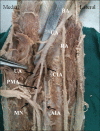Accessory Flexor Carpi Ulnaris and Bilaterally Variant Vascular Anatomy of Upper Limb: An Unusual Presentation
- PMID: 28584749
- PMCID: PMC5441265
- DOI: 10.4103/ijabmr.IJABMR_326_16
Accessory Flexor Carpi Ulnaris and Bilaterally Variant Vascular Anatomy of Upper Limb: An Unusual Presentation
Abstract
We report a rare combination of variations in the upper limb of a human cadaver. Accessory flexor carpi ulnaris with absent palmaris longus was observed in the left forearm during routine dissection of a male cadaver. Variant vascular pattern was observed bilaterally. Brachial artery bifurcated at a higher level. Ulnar artery gave rise to persistent median artery (PMA) which pierced the median nerve and accompanied it deep into flexor retinaculum to terminate as two common palmar digital arteries. Superficial palmar arch was not formed as the PMA did not anastomose with either the radial or ulnar artery. Radial artery was small and deep palmar arch was mainly contributed by the deep branch of ulnar artery. Awareness of these coexistent variations in the forearm and hand is anatomically as well as clinically important in reconstructive hand surgeries.
Keywords: Accessory flexor carpi ulnaris; deep palmar arch; persistent median artery; superficial palmar arch.
Conflict of interest statement
There are no conflicts of interest.
Figures



Similar articles
-
Anatomy, Shoulder and Upper Limb, Ulnar Artery.2023 Jul 24. In: StatPearls [Internet]. Treasure Island (FL): StatPearls Publishing; 2025 Jan–. 2023 Jul 24. In: StatPearls [Internet]. Treasure Island (FL): StatPearls Publishing; 2025 Jan–. PMID: 31536226 Free Books & Documents.
-
The artery blood supply variant of the upper limb.Clujul Med. 2015;88(4):545-9. doi: 10.15386/cjmed-549. Epub 2015 Nov 15. Clujul Med. 2015. PMID: 26733754 Free PMC article.
-
An unusual variation of the superficial ulnar artery.Surg Radiol Anat. 1999;21(2):155-7. doi: 10.1007/s00276-999-0155-1. Surg Radiol Anat. 1999. PMID: 10399219
-
Accessory flexor carpi ulnaris muscle with associated anterior interosseous artery variation: case report with the definition of a new type and review of concomitant variants.Surg Radiol Anat. 2019 Nov;41(11):1315-1318. doi: 10.1007/s00276-019-02261-4. Epub 2019 May 29. Surg Radiol Anat. 2019. PMID: 31144008 Review.
-
High origin of a superficial ulnar artery arising from the axillary artery: anatomy, embryology, clinical significance and a review of the literature.Folia Morphol (Warsz). 2006 Nov;65(4):400-5. Folia Morphol (Warsz). 2006. PMID: 17171623 Review.
Cited by
-
Median artery persistence in coexistence with a bifid median nerve and interconnections of the median with the ulnar nerve and vice versa.Surg Radiol Anat. 2023 Sep;45(9):1097-1102. doi: 10.1007/s00276-023-03183-y. Epub 2023 Jun 27. Surg Radiol Anat. 2023. PMID: 37368116 Free PMC article.
-
Persistent Median Artery as an Unusual Finding in the Carpal Tunnel: Its Contribution to the Blood Supply of the Hand and Clinical Significance.Med Sci Monit. 2019 Jan 2;25:32-39. doi: 10.12659/MSM.912269. Med Sci Monit. 2019. PMID: 30600313 Free PMC article.
References
-
- Niumsawatt V, Soliman BA, Rozen WM. The aberrant flexor carpi ulnaris and its clinical implications. J Plast Reconstr Aesthet Surg. 2013;66:e172–4. - PubMed
-
- Standring S, editor. Gray's Anatomy: The Anatomical Basis of Clinical Practice. 40th ed. London: Elsevier Churchill Livingstone; 2008. pp. 847pp. 903–6.
-
- Carlson BM. Human Embryology & Developmental Biology. 5th ed. Philadelphia: Elsevier Health Sciences; 2014. pp. 206–8.
Publication types
LinkOut - more resources
Full Text Sources
Other Literature Sources

